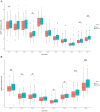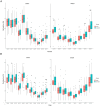Differential methylation of SNCA and MAPT genes associated with Parkinson's disease in Mexican Mestizos
- PMID: 40703677
- PMCID: PMC12283687
- DOI: 10.3389/fnagi.2025.1612544
Differential methylation of SNCA and MAPT genes associated with Parkinson's disease in Mexican Mestizos
Abstract
Introduction: Parkinson's disease (PD) is a neurodegenerative disorder characterized by motor symptoms such as bradykinesia, rigidity, and tremor. Despite its prevalence, genetic and epigenetic studies in the Mexican Mestizo population (individuals of mixed Indigenous and European-primarily Spanish-ancestry who represent the majority demographic in Mexico) remain limited. DNA methylation may play a role in PD pathogenesis, with peripheral blood methylation patterns serving as potential biomarkers. This study examines MAPT and SNCA gene methylation in Mexican PD patients to identify epigenetic alterations associated with the disease.
Methods: In this case-control study, we enrolled 108 PD patients and 108 age- and sex matched controls from Mexico City and Durango. Genomic DNA was extracted from leukocytes, and bisulfite pyrosequencing was performed to assess methylation levels at specific CpG sites within MAPT and SNCA.
Results: Our analysis revealed a significant reduction in global methylation levels in the MAPT promoter region and SNCA intron 1 in PD patients compared to controls (MAPT, p = 0.0019; SNCA, p = 0.000069). Site-specific analysis showed significant hypomethylation at MAPT CpG sites 1, 4, 10-11 and at SNCA CpG sites 1-3, 5-7 and, 25 in PD cases. Regional analysis (central and northern México) revealed significant differences in MAPT methylation between PD patients and controls exclusively in the northern region (p = 0.0039) and in SNCA methylation only in the central region (p = 0.00001). Gender-based stratification indicated that MAPT methylation was significantly different in men (p = 0.0013), whereas SNCA methylation differences were significant only in women (p = 0.00045). We found an association between global methylation patterns of MAPT (OR = 1.182, 95% CI = 1.029-1.197, p = 0.007) and SNCA (OR = 1.243, 95% CI = 1.067-1.448, p = 0.005) with PD. Gender-stratified regression showed that MAPT methylation was significantly associated with PD exclusively in men (OR = 1.182, 95% CI = 1.041-1.342, p = 0.010), whereas SNCA methylation was significantly associated with PD only in women (OR = 1.337, 95% CI = 1.044-1.713, p = 0.021).
Conclusion: Our findings reveal significant MAPT and SNCA hypomethylation in PD patients within the Mexican Mestizo population. These epigenetic modifications may contribute to PD pathogenesis and highlight the potential of DNA methylation profiles as biomarkers for PD, particularly in regional- and gender-specific contexts. This study advances the understanding of PD's molecular mechanisms and underscores the importance of studying diverse populations to identify novel disease biomarkers.
Keywords: DNA methylation; MAPT; Mexican Mestizos; Parkinson’s disease; SNCA.
Copyright © 2025 Miranda-Morales, Ramos-Rosales, Salas-Leal, Salas-Pacheco, Castellanos-Juárez, Méndez-Hernández, La Llave-León, Peñaherrera, Quiñones-Canales, Arias-Carrión, Sandoval-Carrillo and Salas-Pacheco.
Conflict of interest statement
The authors declare that the research was conducted in the absence of any commercial or financial relationships that could be construed as a potential conflict of interest. The author(s) declared that they were an editorial board member of Frontiers, at the time of submission. This had no impact on the peer review process and the final decision.
Figures







References
Associated data
LinkOut - more resources
Full Text Sources
Miscellaneous

